
Catalogue Raisonné. Frieze of the Wise and Foolish Virgins
Search the Catalogue
Frieze of the Wise and Foolish Virgins
Catalogue No. 411
Artist's CR 379x
1978
Kinkell
Bronze
48 x 840 inches / 122 x 2134 cm , approximately
Collection: Private collection
- Gerald Laing: Paintings and Sculpture 1963–1983, Herbert Art Gallery & Museum, Coventry, 1983
- Gerald Laing: A Retrospective 1963–1993, The Fruitmarket Gallery, Edinburgh, 1993
- Gerald Laing: Sculpture 1968–1999, The Fine Art Society, London, 1999
- Gerald Laing, 'Notes on ‘The Wise and Foolish Virgins’', unpublished manuscript, 0
- An Exhibition of Sculpture by Gerald Laing at the Edinburgh Festival 1978, exhibition catalogue, Gladstone Court, 1978
- 'The Wise Virgins of George Street', Cockburn Association Magazine, February
- Gerald Laing: Paintings and Sculpture 1963–1983, exhibition catalogue, Herbert Art Gallery & Museum, 1983
- 'Divisive Sculptor on the Trail of the Great Detective', Inverness Courier, 1990
- Gerald Laing: A Retrospective 1963–1993, exhibition catalogue, The Fruitmarket Gallery, 1993
- Clare Henry, 'Fruitful Transformation', Herald, 20 August
- Gerald Laing, 'Apostasy', Northern Review, 1998
- Gerald Laing: Sculpture 1968–1999, exhibition catalogue, The Fine Art Society, 1999
- 'Exhibiting Close to Home', Ross-shire Journal, 30 August
- Gerald Laing: From 1963 to the Present, exhibition catalogue, Bourne Fine Art, 2004
- Tam Dalyell, 'Gerald Laing: Artist whose work encompassed Sixties Pop Art and figurative sculpture', Independent, 25 November
The Parable of the Wise and Foolish Virgins seems at first glance to be unkind, almost un-Christian because of the ruthless way in which the Wise Virgins refuse to share their oil the their feckless sisters. The implication is that each of us is responsible for our own spiritual well-being. It is a ‘Samuel Smiles’ approach to religion.
In the three major sculptures on this theme which I have made for the same client during the past twenty years, I have dealt with this paradox in different ways.
On the 1 George Street frieze (1980) the Foolish Virgins appear as individuals, all varied, and some representing real people. Each demonstrates a different weakness, if not quite a sin.
On the other hand, the Wise Virgins are absolutely identical with one another, on the principle that, if they are perfect then they would necessarily be the same, and with the additional implied suggestion that it is individual identity - the ego - which brings no peace. Douglas Hall, who at the time was the Keeper of the National Gallery of Modern Art, referred to this in an article as an ‘irritating dialectic’.
Unfortunately these Wise Virgins seem dull compared with the chaotic Foolish Virgins and thereby give credence to the suggestion that goodness might be boring, and that the Devil really may have the best tunes.
In Axis Mundi... I suggested that the Foolish Virgins might be included, wistful or struggling, at the base of the obelisk; eventually they were omitted altogether and only the Wise Virgins appear, this time as individual, going to their reward which I thought of as an apotheosis. The sculpture is a depiction of that supreme moment.
In the Glass Virgins (1999) the Wise Virgins express various forms of strength and ecstasy; they know who they are and where they are going. The Foolish Virgins show weakness, confusion and vacillation. Both Wise and Foolish Virgins are individuals who differ from one another. Thus, twenty years on, I have avoided the ‘Irritating dialectic’ and made the positive more interesting and attractive than the negative.
The cloud forms above these figures echo their concerns in form, rhythm and texture; the central Wise Virgin displays the image for God which is common to all three sculptures, and the central Foolish Virgin is dominated by a serpent with its reference to self-devouring, infinity, and the fall.
The contrast between the solid and opaque and constant symbols above these figures, and the fugitive quality of the figures themselves as they appear, disappear and re-form in the changing light is a metaphor for the transitory nature of human existence.
Standard Life's Wise and Foolish Virgin Sculptures, Gerald Laing, leaflet, Kinkell, 1999
A sculpture frieze. The sculpture is approximately 70ft. long by 4ft high and weighs about 2.5 tons. It is cast in bronze. The maximum relief is 8” from the background and the figures are twice life-size.
The composition of the sculpture is related to that of the building due to close co-operation between the architect and the sculptor.
The Wise and Foolish Virgins: A Sculpture Frieze by Gerald Laing, Gerald Laing, booklet, The Michael Laird Partnership, Edinburgh, 1999
The frieze is a figurative narrative sculpture with a religious subject matter.
In the parable of the Wise and Foolish Virgins (see opposite) the oil for the lamps is a metaphor for religious conviction, or faith. The marriage is a metaphor for enlightenment, heaven, and the conquest of decay and death.
The frieze maybe ‘read’ from right to left. The figures on the left are the Wise Virgins, who have prepared themselves for death through faith in God; those on the right are the Foolish Virgins, who have failed to do this and instead are caught up in various mundane preoccupations.
The extreme right hand end of the frieze is considered as the direction from which negative forces, or the devil, is approaching; the left-hand end represents positive forces, or God.
The Wise and Foolish Virgins: A Sculpture Frieze by Gerald Laing, Gerald Laing, booklet, The Michael Laird Partnership, Edinburgh, 1999
The Palindrome.
This is an early Christian secret symbol, which being interpreted by the initiated forma the following sign: or, in other words, ‘Our Father, the Beginning and the End’. This is the idea towards which the Wise Virgins are travelling.
The Wise and Foolish Virgins: A Sculpture Frieze by Gerald Laing, Gerald Laing, booklet, The Michael Laird Partnership, Edinburgh, 1999
The Wise Virgins are prepared to meet God and are travelling towards the left-hand end of the frieze in order to do so. Their transcendence has rendered them perfect, and, being perfect, they are necessarily identical and equal. This is, indeed, a part of their reward. For as perfection grows, either accordingly to the sin and repentance metaphor of Christianity, or the recurring existence (reincarnation) metaphor of Buddhism, or any other set of rules produced by man to give form to a process which he is not, by his nature and by the circumstances, fully equipped to comprehend, it does follow quite logically that the perfection of each human being will result in their becoming identical, with consequent ego loss and even the possibility of entering and becoming part of the mass consciousness.
All of the Wise Virgins express individuality of a sort but this tends to isolate them from one another
The Wise and Foolish Virgins: A Sculpture Frieze by Gerald Laing, Gerald Laing, The Michael Laird Partnership, Edinburgh, 1999
The Foolish Virgins.
Wistfulness.
The wisest of the Foolish Virgins, this figure sensed the truth, but failed to act upon it. She is the only only one of the Foolish Virgins who can see the departing Wise Virgins, and who is fully aware of the different fates of the two groups. I suspect that this relates in some way to the idea of hubris and to the story of Lucifer, and indeed to the final and worst sin in the Buddhist faith.
Self-absorption.
An aspect of vanity; a consequence of alienation. This type of egocentricity blinkers us to any external influence.
Panic.
A consequence of the attitude of the previous figure. The realisation that ‘in the midst of life we are in death’, that life may be seen as a fragile rope which suspends us over a dark abyss, and which may be cut without warning at any time.
Despair.
This figure cannot face the fact of death, nor the necessity of faith, but nevertheless recognise their existence. Consequently she is left in a desolate wasteland.
Procrastination.
This figure is that of a kind, polite, but unrealistic person attempting to calm down or ward off the onslaught of the negative forces to which she and the other Foolish Virgins have rendered themselves vulnerable through their refusal to address the rest of mortality.
The Wise and Foolish Virgins: A Sculpture Frieze by Gerald Laing, Gerald Laing, booklet, The Michael Laird Partnership, Edinburgh, 1999

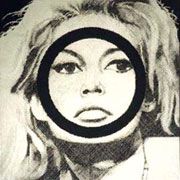
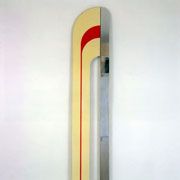
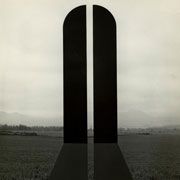

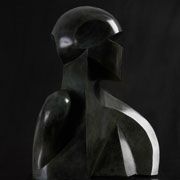
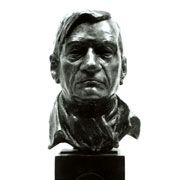
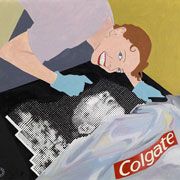
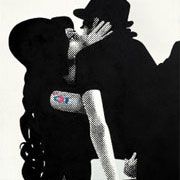



 Maquette for Frieze of the Wise and Foolish Virgins - Two Wise Virgins
Maquette for Frieze of the Wise and Foolish Virgins - Two Wise Virgins